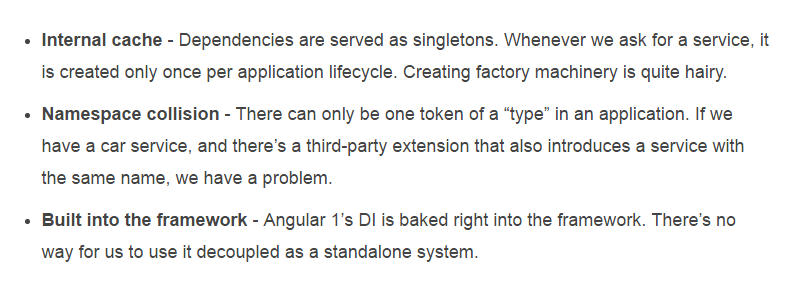Orgial aritial --> Link
The problem with Angular 1 DI:

Angular 2 DI:
- Solve the singletons problem:
The service you inject to the parent component can be differnet with the one you inject to child component:
var injector = ReflectiveInjector.resolveAndCreate([Engine]); var childInjector = injector.resolveAndCreateChild([Engine]); injector.get(Engine) !== childInjector.get(Engine);
`resolveAndCreate` & `resolveAndCreateChild` are function to create injector.
Even here use the same service `Engine`, but the instances are different.
In Angular2, it looks like:
// child component @Component({ selector: 'child', providers: [Engine], template: '<h1> childcomponent !</h1>' }) class Child{ ... } // parnet component @Component({ selector: 'parent', providers: [Engine], template: '<h1> parent component !</h1>' }) class Parent { ... }
The `Engine` we inject into Child component is a new instance, which is not the same as parent one.
So what if we want to share the same instance?
Well, If child component and parent component want the same service, then we only inject servie to parent component. The child component can access parent component's injected service.
So in code, it will looks like:
// child component @Component({ selector: 'child', providers: [], template: '<h1> childcomponent !</h1>' }) class Child{ ... } // parnet component @Component({ selector: 'parent', providers: [Engine], template: '<h1> parent component !</h1>' }) class Parent { ... }
We just remove 'Engine' from Child component, now they share the same service instance.
- Solve name collision problem:
Angular 2 allows you configure the service differently:
- useClass:
provide(Engine, {useClass: OtherEngine})
2. useValue:
provide(String, {useValue: 'Hello World'})
3. useExisting:
provide(V8, {useExisting: Engine})
4. useFactory:
provide(Engine, {useFactory: () => {
return function () {
if (IS_V8) {
return new V8Engine();
} else {
return new V6Engine();
}
}
}})
Of course, a factory might have its own dependencies. Passing dependencies to factories is as easy as adding a list of tokens to the factory:
provide(Engine, { useFactory: (car, engine) => { }, deps: [Car, Engine] })







 本文详细介绍了 Angular 2 的依赖注入系统如何解决单例和服务实例化的问题,并提供了多种配置服务的方式,如 useClass、useValue、useExisting 和 useFactory。通过示例展示了父组件与子组件间如何共享相同的服务实例。
本文详细介绍了 Angular 2 的依赖注入系统如何解决单例和服务实例化的问题,并提供了多种配置服务的方式,如 useClass、useValue、useExisting 和 useFactory。通过示例展示了父组件与子组件间如何共享相同的服务实例。

















 2760
2760

 被折叠的 条评论
为什么被折叠?
被折叠的 条评论
为什么被折叠?








